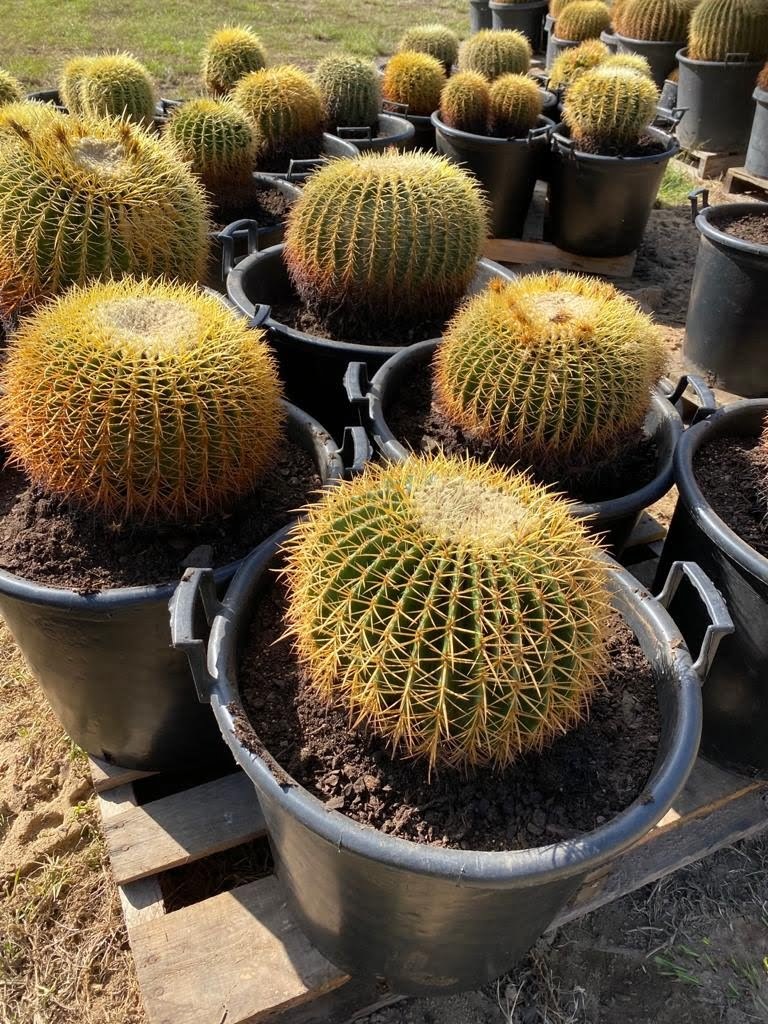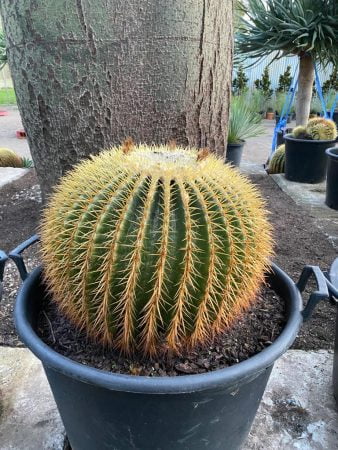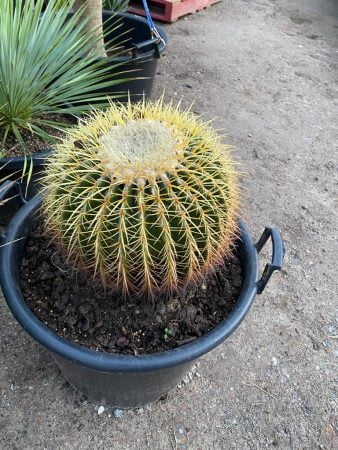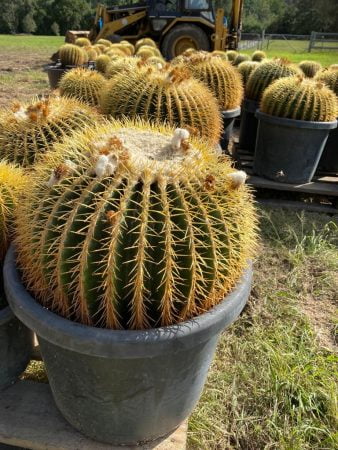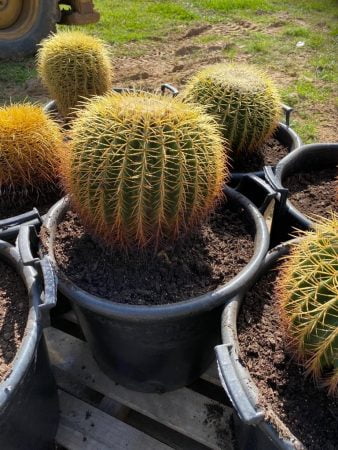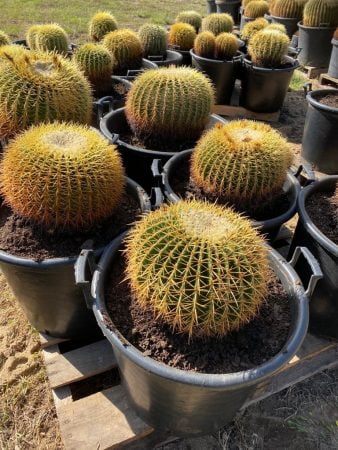Golden Barrel Cactus
Golden Barrel Cactus (Echinocactus grusonii)
| Scientific name: | Echinocactus grusonii |
|---|---|
| Common names: | Golden Barrel Cactus, Mother-in-Law’s Cushion, Golden Ball, Compass Cactus, Hedgehog Cactus |
| Synonyms: |
|
| Did you know? | The Golden Barrel cactus has been awarded an ‘Award of Garden Merit’ by the United Kingdom’s Royal Horticultural Society. An AGM is a truly prestigious award! |
| Uses: | Over time the Golden Barrel Cactus will tend to lean towards the sun. Desert travellers use the plant as a natural compass.
The fruit of the Golden Barrel cactus is considered to be one of the better tasting cactus fruits. The flower buds, pulp, fruit and seeds of many types of Barrel Cactus were eaten by native tribes with the fruits being a particularly good source of Vitamins A & C. |
About Golden Barrel Cactus
The Golden Barrel Cactus is one of the most popular Cacti in cultivation. It is seen in Botanical Gardens, homes and offices the world over. Its golden spines contrast beautifully with the spherical green body and this pincushion effect gives it a wonderfully exotic appearance. It is commonly used by landscapers in modern planting schemes as its curves nicely offset what are often harsh architectural designs.
The Golden Barrel Cactus is incredibly robust and considered as being a carefree addition to Xeriscapes, Mediterranean or rock gardens. It is also a popular house or office plant throughout the world. Relatively drought-resistant and generally pest and disease free, The Golden Barrel Cactus will grow in any soil as long as it is free draining – the only problems associated with this spectacular plant tend to come from lack of drainage which can bring about root rot.
Reportedly hardy, for brief periods down to -8C, it grows best in areas with a minimum winter temperature no lower than 10C. It will happily grow in gardens as far south as Melbourne without the need for any particular winter care. However, it does not thrive in the tropical and sub-tropical climates of the north due to the higher rainfall and humidity levels.
We have a wide range of sizes, and ages, of Golden Barrel Cactus in stock and we, are always happy to help you choose the perfect specimen for your site. They look wonderful when planted next to contrasting blue plants and always look great planted singly as a feature plant, providing a focal point or anchor within the garden design. But, in the wild it has a clustering habit that can be recreated to spectacular effect by closely planting multiple specimens, bringing a soft, rolling texture to your landscape.
On a final but amusing note, the Golden Barrel’s nickname is the “mother-in-law’s cushion”, and it’s easy to assume why although the exact origin of the nickname is not known.
Frequently Asked Questions
Golden Barrel Cactus: What climate suits it best?
The Golden Barrel Cactus grows best in areas with a minimum winter temperatures no lower than 10C. It will happily grow in gardens as far south as Melbourne. The Golden Barrel Cactus does not thrive in the tropical and sub-tropical climates due to the higher rainfall and humidity levels.
Continue reading about Golden Barrel Cactus care.
Golden Barrel Cactus: Does it have any uses?
Although all cactus fruit are edible, not all are palatable. The fruit of the Golden Barrel cactus is considered to be one of the better tasting cactus fruits.
Continue reading about Golden Barrel Cactus care.
Golden Barrel Cactus: What kind of maintenance do they need?
Generally pest and disease free and requiring no pruning at all, a Golden Barrel Cactus requires very little, if any, ongoing care and maintenance.
Continue reading about Golden Barrel Cactus care.
Where can I buy a Golden Barrel Cactus?
We are one of the leading suppliers of Golden Barrel Cactus in Australia. We are fully licensed by the NSW Office of Environment and Heritage to sustainably harvest several species and we are proud to say that we have one of the largest ranges of Golden Barrel Cactus.
Click here to get a quote.
Our Golden Barrel Cactus
- Golden Barrel Cactus 015
- Golden Barrel Cactus 017
- Golden Barrel Cactus 018
- Golden Barrel Cactus 016
- Golden Barrel Cactus 012
- Golden Barrel Cactus 011
- Golden Barrel Cactus 010
- Golden Barrel Cactus 009
Request A Quote Now.
Call Us For An Instant Quote!
Australia:
0461 486 193
International:
+61 461 486 193
Email – hello@designertrees.com.au
